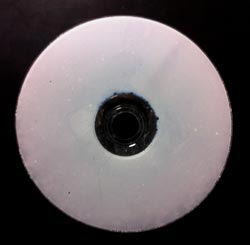Spinning CDs to Clean Sewage Water

Figure 1: This image shows an optical disk entirely coated with zinc oxide nanorods. (Photo credit: Din Ping Tsai, National Taiwan University)<br>
Audio CDs, all the rage in the ‘90s, seem increasingly obsolete in a world of MP3 files and iPods, leaving many music lovers with the question of what to do with their extensive compact disk collections. While you could turn your old disks into a work of avant-garde art, researchers in Taiwan have come up with a more practical application: breaking down sewage.
The team will present its new wastewater treatment device at the Optical Society's (OSA) Annual Meeting, Frontiers in Optics (FiO) 2013, being held Oct. 6-10 in Orlando, Fla.
“Optical disks are cheap, readily available, and very commonly used,” says Din Ping Tsai, a physicist at National Taiwan University. Close to 20 billion disks are already manufactured annually, the researchers note, so using old disks for water treatment might even be a way to cut down on waste.
Tsai and his colleagues from National Taiwan University, National Applied Research Laboratories in Taiwan, and the Research Center for Applied Sciences in Taiwan used the large surface area of optical disks as a platform to grow tiny, upright zinc oxide nanorods about a thousandth the width of a human hair. Zinc oxide is an inexpensive semiconductor that can function as a photocatalyst, breaking apart organic molecules like the pollutants in sewage when illuminated with UV light.
While other researchers have experimented with using zinc oxide to degrade organic pollutants, Tsai’s team is the first to grow the photocatalyst on an optical disk. Because the disks are durable and able to spin quickly, contaminated water that drips onto the device spreads out in a thin film that light can easily pass through, speeding up the degradation process.
The Taiwanese team’s complete wastewater treatment device is approximately one cubic foot in volume. In addition to the zinc oxide-coated optical disk, the device consists of a UV light source and a system that recirculates the water to further break down the pollutants.
The research team tested the reactor with a solution of methyl orange dye, a model organic compound often used to evaluate the speed of photocatalytic reactions. After treating a half-liter solution of dye for 60 minutes, they found that over 95 percent of the contaminants had been broken down. The device can treat 150 mL of waste water per minute, the researchers say.
The spinning disk reactor is small, consumes little power, and processes contaminated water more efficiently than other photocatalytic wastewater treatment methods, Tsai says. The device could be used on a small scale to clean water contaminated with domestic sewage, urban run-off, industrial effluents, and farm waste. Going forward, the team is also working on ways to increase the efficiency of the reactor, and Tsai estimates that the system could soon be improved to work even faster, perhaps by creating layers of stacked disks.
Presentation FW1A, “Zinc Oxide Nanorod Optical Disk Photocatalytic Reactor for Photodegradation,” takes place Wednesday, Oct. 9 at 8:15 a.m. EDT at the Bonnet Creek Ballroom, Salon IV at the Hilton Bonnet Creek in Orlando, Fla.
EDITOR’S NOTE: Images and a video demonstration of the system are available to members of the media upon request. Contact Lyndsay Meyer, lmeyer@osa.org.
PRESS REGISTRATION: A press room for credentialed press and analysts will be located in the Hilton Bonnet Creek, Sunday through Thursday, Oct. 6-10. Those interested in obtaining a press badge for FiO should contact OSA's Lyndsay Meyer at 202.416.1435 or lmeyer@osa.org.
About the Meeting
Frontiers in Optics (FiO) 2013 is the Optical Society’s (OSA) 97th Annual Meeting and is being held together with Laser Science XXIX, the annual meeting of the American Physical Society (APS) Division of Laser Science (DLS). The two meetings unite the OSA and APS communities for five days of quality, cutting-edge presentations, fascinating invited speakers and a variety of special events spanning a broad range of topics in optics and photonics—the science of light—across the disciplines of physics, biology and chemistry. An exhibit floor featuring leading optics companies will further enhance the meeting. More information at www.FrontiersinOptics.org.
About OSA
Founded in 1916, The Optical Society (OSA) is the leading professional society for scientists, engineers, students and business leaders who fuel discoveries, shape real-world applications and accelerate achievements in the science of light. Through world-renowned publications, meetings and membership programs, OSA provides quality research, inspired interactions and dedicated resources for its extensive global network of professionals in the optics and photonics field.
Media Contact
More Information:
http://www.osa.orgAll latest news from the category: Process Engineering
This special field revolves around processes for modifying material properties (milling, cooling), composition (filtration, distillation) and type (oxidation, hydration).
Valuable information is available on a broad range of technologies including material separation, laser processes, measuring techniques and robot engineering in addition to testing methods and coating and materials analysis processes.
Newest articles

NASA: Mystery of life’s handedness deepens
The mystery of why life uses molecules with specific orientations has deepened with a NASA-funded discovery that RNA — a key molecule thought to have potentially held the instructions for…

What are the effects of historic lithium mining on water quality?
Study reveals low levels of common contaminants but high levels of other elements in waters associated with an abandoned lithium mine. Lithium ore and mining waste from a historic lithium…

Quantum-inspired design boosts efficiency of heat-to-electricity conversion
Rice engineers take unconventional route to improving thermophotovoltaic systems. Researchers at Rice University have found a new way to improve a key element of thermophotovoltaic (TPV) systems, which convert heat…



